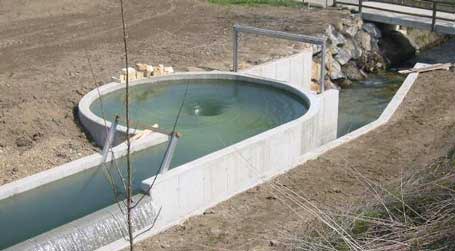In a fairly radical departure from the principles that normally govern hydroelectric power generation, Austrian engineer Franz Zotlöterer has constructed a low-head power plant that makes use of the kinetic energy inherent in an artificially induced vortex. The water's vortex energy is collected by a slow moving, large-surface water wheel, making the power station transparent to fish - there are no large pressure differences built up, as happens in normal turbines.
The aspect of the power plant reminds a bit of an upside-down snail - through a large, straight inlet the water enters tangentially into a round basin, forming a powerful vortex, which finds its outlet at the center bottom of the shallow basin. The turbine does not work on pressure differential but on the dynamic force of the vortex. Not only does this power plant produce a useful output of electricity, it also aerates the water in a gentle way. Indeed, the inventor was looking for an efficient way to aerate the water of a small stream as he hit upon this smart idea of a plant that not only gives air to the medium but also takes from it some of the kinetic energy that is always inherent in a stream.
Of course the use of water vortices has been pioneered by another Austrian - Viktor Schauberger, who was also known as the "water wizard". He floated hard-to transport heavy logs from remote regions of the Austrian forests, not accessible at the time by streets, to where they would be milled and processed. The feat was accomplished by carefully regulating the water's temperature and by inducing a rolling, longitudinal vortex motion in the water.
At one point, Schauberger took out a patent on a turbine he invented, that made use of vortex dynamics. An article about that turbine of Schauberger's which I wrote way back in the 90s can be found here. The turbine wheel was designed in the form of a cone with a cork screw pattern, and it was fast running. Quite different from the turbine of Zotlöterer which is optimized for aerating the water, rather than for production of power.
Still, Zotlöterer's results are quite respectable. The cost of construction for his plant was half that of a conventional hydroelectric installation of similar yield and the environmental impact is positive, instead of negative.

